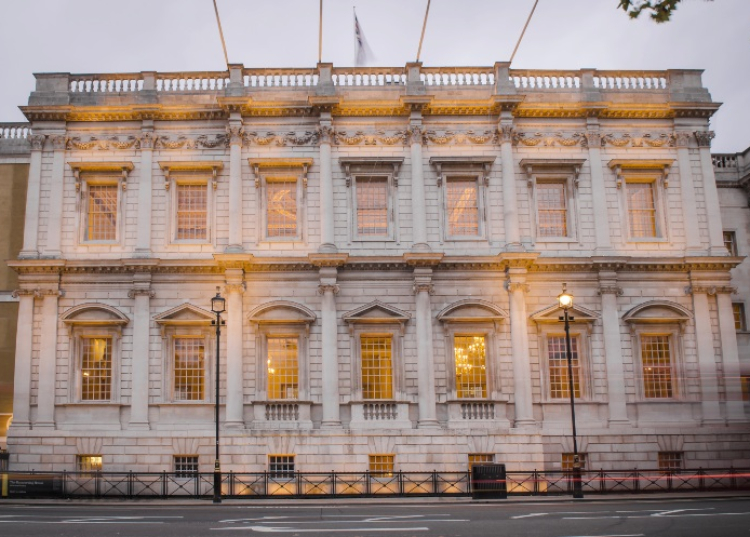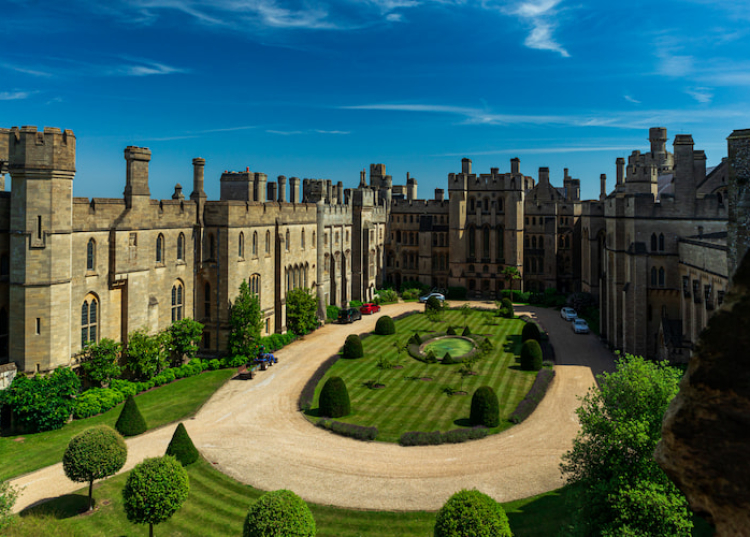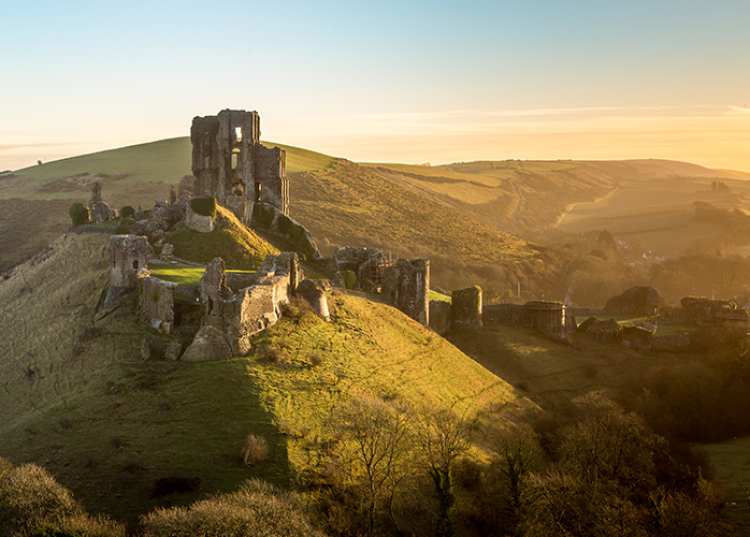When it comes to travel inspiration, there’s little doubt that the battlefields of the English Civil War provide endless possibilities with famous locations such as Edgehill, Banqueting House and Ashby Castle being among the most popular places to visit.
While some English Civil War battlefields are widely renowned and attract hordes of tourists each and every year, others fly under the radar, such as Goodrich Castle.
Here are 10 key places to see while exploring the landmarks from the English Civil War.

1. Edgehill Battlefield
Edgehill Battlefield was the location of the first major engagement of the English Civil War and thus stands as the location of a crucial turning point in English history.
The battle itself came about after King Charles I and Parliament became locked in an increasingly dangerous political struggle for supremacy. By the summer of 1642, both sides had raised armies and Charles began to lead his forces towards London, in the hope of achieving a quick, decisive victory.
A Parliamentarian army led by the Earl of Essex was sent to block the King, though both sides seemed to have little intelligence on the whereabouts of the other. Indeed, it was almost by accident that the two forces blundered into each other at Edge Hill in southern Warwickshire, and the resulting battle was fought on 23rd October 1642, largely ending in a costly and bloody stalemate.
The clash remains one of the largest and most significant battles of the English Civil War, and was the first time the armies of Parliament and the King formally deployed opposite each other; it irretrievably signalled the start of a long and bloody conflict.
Visitors to the site can gain an understanding of the battlefield by walking a number of routes around the area, with information boards detailing its history. Much of the battlefield remains either private agricultural land or under Ministry of Defence ownership however.

2. Banqueting House
The Banqueting House in Whitehall, near Horseguards Parade, is the only complete building of the Palace of Whitehall to remain standing. The original Palace of Whitehall was acquired from Cardinal Wolsey by Henry VIII and was a royal residence until James I came to the throne in 1603.
The Banqueting House was built for state occasions and, after the installation of grand ceiling panels, the Banqueting House became a reception area for greeting foreign dignitaries.
On 30 January 1649, many spectators gathered to watch the beheading of King Charles I on the balcony of the Banqueting House. A service is held at the Banqueting House every year in January to commemorate this event and visitors can still see the scaffold stage on which the monarch died.
From 1654 until 1658, the Palace of Whitehall was the home of the revolutionary and statesman, Oliver Cromwell. After the restoration of King Charles II to the throne in 1660, the Palace of Whitehall once again became the royal residence and the Banqueting House once again was used for its original purpose.
In 1698, a huge fire burned Whitehall Palace to the ground. Sir Christopher Wren was commissioned to convert the Banqueting House into a chapel to replace the one destroyed in the fire.

3. Ashby Castle
Ashby Castle or ‘Ashby de la Zouch’ is a twelfth century manor house turned castle, the ruins of which can be seen in Leicestershire. Originally constructed during Norman times, Ashby Castle was the property of the Zouch family until the end of the fourteenth century.
Expanded and renovated, Ashby Castle achieved the transition from a stately home to a castle in the fifteenth century, after which it was the site of several royal visits from the likes of Henry VII and Charles I. Amongst its additions during this time, Ashby Castle gained the imposing 24-metre high Hastings Tower, built by Lord Hastings.
The demise of Ashby Castle occurred following the English Civil War. During the war, the castle had served as a Royalist base, but in 1646 it was taken by the Parliamentarians and subsequently fell into disuse. Ashby Castle would later inspire Sir Walter Scott, who set certain jousting scenes from his nineteenth century novel Ivanhoe at the site.
Visitors to Ashby Castle can immerse themselves in the site’s history, from enjoying entertaining audio tours and exploring its sunken gardens to embarking on tours of its underground passageways.

4. Arundel Castle
Arundel Castle is the historic home of the Dukes of Norfolk, having been occupied by their line for over 850 years. Amongst the dynasties to have inhabited Arundel Castle, the highly influential Howard family are most notable, and still occupy the eminent site today. With aspects dating from the medieval and early modern periods, Arundel Castle is the perfect visit for anyone looking to immerse themselves in Britain’s fascinating past.
The first structure on the Arundel Castle site was built in the 11th Century by the Normans after the invasion of William the Conqueror, with the earthworks and first buildings completed by 1070. William d’Aubiny, the first Earl of Arundel, inherited the castle in 1138, followed by the FitzAlan family in the 13th century who undertook a large programme of renovation.
In the 16th century, Arundel Castle came into the possession of the Howard family when FitzAlan heiress Mary married Thomas Howard, 4th Duke of Norfolk. His grandfather had been the eminent 3rd Duke of Norfolk and uncle of both Catherine Howard and Anne Boleyn, Henry VIII’s ill-fated second and fifth wives. Thomas Howard, 4th Duke of Norfolk himself would be executed by Elizabeth I for his involvement in the Ridolfi plot, in which he conspired to marry Mary, Queen of Scots and place her on the throne.
During the English Civil War, Arundel Castle was besieged twice – first by the Royalists who successfully captured the site and then by the Parliamentarians, whose siege lasted 18 days. Following this, Parliament ordered the slighting of the castle, a process that deliberately damaged it to reduce its value as a royal military stronghold.
Today, Arundel Castle remains a vast complex, with many original features still intact such as the Norman Keep, medieval Gatehouse, and Barbican. It is home to an impressive array of priceless artwork, such as works by Van Dyck, Gainsborough and Canaletto, as well as a vast collection of furniture, sculptures and tapestries.

5. Corfe Castle
Corfe Castle is a stunning 11th century castle in Dorset, that has fulfilled a number of roles throughout its thousand-year history – from royal residence to military stronghold. Today Corfe Castle provides an atmospheric look into Britain’s medieval past, with its picturesque views and imposing structure attracting visitors from far and wide.
The current incarnation of Corfe Castle was built by William the Conqueror in around 1066, although even before this the site was of great historical importance. Legend tells that when a Saxon hall stood on the site, the young Edward the Martyr was murdered there in 978 during a plot to position his half-brother Ethelred ‘the Unready’ as monarch. Edward was later canonised, with his feast day falling on the anniversary of his death – 18 March.
Following its construction as a medieval fortress, Corfe Castle would be expanded and altered over the coming centuries, especially in the 12th century by Edward I who built the imposing keep, and in the 13th century under King John. Not only did John further fortify the castle, he also used it as a prison and royal residence. Sold by Elizabeth I in 1572, Corfe Castle became a grand private home, first to Sir Christopher Hatton and later by Sir John Bankes in 1635.
The demise of Corfe Castle and the cause of its current ruined state came with the English Civil War. Having survived one siege in 1643, it would fall to another only 3 years later, before being slighted – or intentionally damaged – by the Parliamentarians. Its ruins were eventually handed back to the Bankes family, who retained it for 350 years before in 1982 gifting it to the National Trust.
Today, Corfe Castle remains under the remit of the National Trust and is open to the public.

6. Goodrich Castle
Goodrich Castle in Herefordshire is one of the most picturesque medieval ruins in the UK. Standing at the peak of a scenic woodland hilltop, this Norman fortification has attracted tourists to view its ethereal remains since the 18th century.
The first recorded structure to be built on the Goodrich Castle site was constructed in the late 11th century by an Anglo-Saxon thegn who retained his lands after the Norman Conquest. However, it is believed that the site may have been used as a fortification for far longer.
The original wooden structure was replaced by a stone fort in the mid-12th century and the living quarters and fortifications of Goodrich Castle were extended over the next 100 years.
Goodrich Castle is perhaps best known for the part it played during the English Civil War, when it became the focus of a bitter siege between Royalist and Parliamentarian forces. Occupied by a Royalist garrison at the start of the war, Goodrich Castle was used as a base for attacks on Parliamentarian positions in the local area.
As the war turned however, Parliamentarian forces targeted Goodrich and a siege began in 1646. After building trenches and utilising the famous ‘Roaring Meg’ mortar, the Parliamentarians began to wreak heavy damage upon Goodrich Castle and the defending garrison was forced to surrender.
After the war, although Goodrich Castle was not destroyed, it was intentionally damaged to ensure it could no longer serve as a stronghold.
By the late 18th century, Goodrich Castle was seen as a idyllic ruin and was therefore never fully restored.
Today the Goodrich Castle site is run by English Heritage and visitors can wander through the ruins and even see the infamous ‘Roaring Meg’ mortar.
Views from the castle walls are a must-see, and be sure to look out for the eery murder-holes dotted along them – once used to keep out enemy troops!

7. Helmsley Castle
Helmsley Castle is a large medieval fortress and mansion in the town of Helmsley, Yorkshire. Today its well-preserved ruins provide a fascinating look into Britain’s Civil War past, with the towering architecture of the Middle Ages a picturesque backdrop.
Initially built as a timber construction by the influential baron and military man Walter l’Espec in 1120, it was converted to stone by his nephew, Robert de Roos and further expanded over the 12th and 13th centuries.
In the 16th century the old hall was transformed into a Tudor mansion by the Earls of Rutland, and eventually passed into the keeping of George Villiers, Duke of Buckingham – a favourite of the Stuart monarchs.
During the English Civil War, Helmsley Castle managed to endure a massive attack by the Parliamentarians for a staggering 3 months, only falling when food and supplies ran dry.
Following the Parliamentarian occupation of Helmsley Castle it was slighted, or intentionally damaged to avoid further military use, yet the manor house was saved. In an intriguing instance of cross-factional politics, Sir Thomas Fairfax’s daughter married the Duke of Buckingham’s son, thus Helmsley remained in the family of both its Royalist and Parliamentarian ancestors.
Today there are several Civil War displays looking at the castle’s domestic, social, and military history, with both cannonballs and tableware on display alongside a tactile model of what the fortress once looked like.

8. Pembroke Castle
A great medieval castle in the heart of South Wales, Pembroke Castle was originally the family seat of the Earldom of Pembroke. The castle was built alongside Pembroke River in 1093 by Arnulf of Montgomery during the Norman invasion of Wales.
The wooden bailey was built in 1093 on an easily defensible rocky area near the Milford Haven Waterway.
In 1189, Richard I gave Pembroke Castle to William Marshal, who became Earl of Pembroke and shorty after rebuilt the castle with stone. Marshall’s castle boasted a great keep almost 80 metres high with embellished windows. The castle passed to William de Valence, half-brother of Henry III.
In 1400, the Welsh soldier and patriot Owain Glyndwr led another rebellion against the English settlers. Pembroke Castle escaped attack because then constable Francis a Court paid off the rebels with a danegeld (a tax that was customarily paid to Viking raiders to prevent them from attacking settlements). Harri Tudor, who later became Henry VII of the Tudor dynasty, was born at Pembroke Castle in 1457.
During the tumultuous reign of Charles I, Pembroke Castle was attacked by both Royalist and Roundheads as the castle occupants’ sympathies shifted: first siding with Parliament then later the Royalists. Cromwell himself led an attack on the castle in 1648. After 7 weeks of siege, he ordered the castle’s destruction. Pembroke was therefore abandoned and fell into decay.
In 1928, Major-General Sir Ivor Philipps acquired the castle and set about restoring the walls, gatehouses and towers to the glorious castle we see today.

9. Pontefract Castle
Pontefract Castle was a key strategic military stronghold in Northern England which played a crucial role in many of the country’s most bitter conflicts for over 500 years.
The land that now houses the remains of one of the most notorious castles in England was given to Ilbert de Lacy soon after the Norman Conquest of 1066AD.
During their tenure they continued to improve the castle, upgrading the original motte and bailey structure with a more permanent and larger military fortress which the famous king Edward I described as the “key to the north”.
One of the most infamous moments in Pontefract Castle’s history came in 1399, when Henry IV, a Lancastrian, used it to imprison and murder the deposed king Richard II. With the accession of the Lancastrians to the throne, Pontefract quickly began to hold a key position in the north of England, growing in size and importance whilst other castles nearby dwindled. Pontefract remained a Lancastrian stronghold during the Wars of the Roses.
Other notable events said to have taken place here include the surrender of the castle to the ‘Pilgrimage of Grace’ rebels – who rose up against Henry VIII – as well as being a setting for the infamous liaisons between Catherine Howard, and Thomas Culpeper.
During the English Civil War it was the last Royalist fortress to surrender and underwent numerous sieges until Parliament, more specifically Oliver Cromwell, ordered its demolition following Charles I’s execution.
Today Pontefract Castle hold but a shadow of its former glory. Parts of the original motte and bailey wall can still be seen, as can remnants of the chapel.
Recent excavation at the castle has unearthed many English Civil War items, both domestic and military, from helmets and spurs to spoons and combs.

10. Broughton Castle
Broughton Castle in Oxfordshire is a medieval fortified manor house in Oxfordshire, surrounded by a three-acre moat and set amongst scenic parkland. Despite its name, Broughton is more a fortified manor house than a castle, and has been the family seat of the Fiennes family (who hold the title Lord and Lady Saye and Sele) since the 15th century.
Among the most important historical events to occur at Broughton Castle took place during English Civil War, when then-owner William Fiennes was a strong opponent of Charles I. Fiennes refused to take the Oath of Allegiance to the King, and Broughton became a key meeting place for those set against him.
During the Civil War, Fiennes raised a regiment against the Crown and with his four sons fought at the Battle of Edgehill, following which Broughton Castle fell under siege and was captured. Later in the conflict however, William actually opposed the execution of Charles I and stepped away from public office over the matter. As a result, a pardon was granted to him from Charles II after the Restoration of the Monarchy in 1660.


